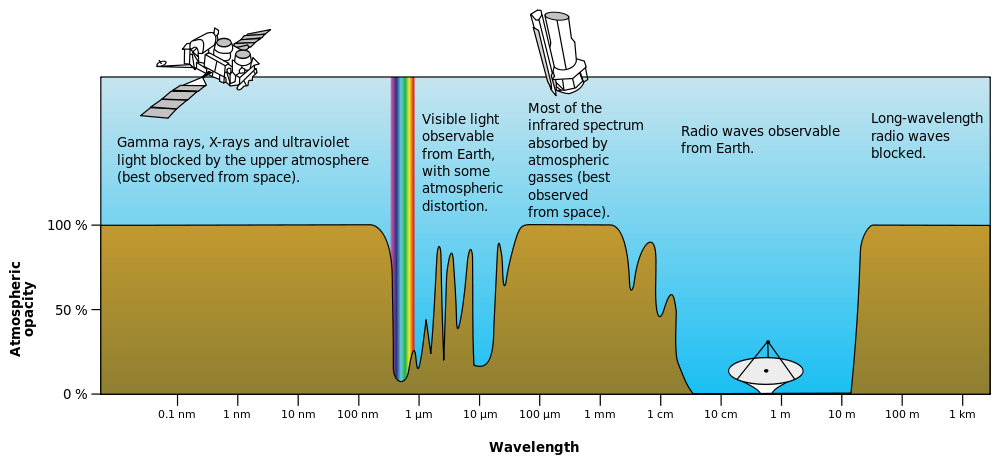The Science Behind It All
How far, how fast?
Radio waves travel at the speed of light. Radio messages beamed into space will travel 186,000 miles after the first second of being transmitted. Within two seconds this message will have passed the orbit of the Moon. In just over three minutes it will pass beyond the orbit of Mars. And in 1.87 years the message will speed past the outer edge of the Oort Cloud and into interstellar space. At this point, it will have travelled 45% of the way to Proxima Centari, the nearest star to our sun.

Astronomers use radio telescopes to determine the nature of objects in the Universe that cannot be determined by viewing visible light from those objects alone. Using these longer wavelength photons, astronomers are able to receive and analyze signals from sources that are billions of light years from Earth. Some of these signals were emitted before the Earth was formed!
SpaceSpeak
Note the illustration of the electromagnetic spectrum above. Much of it is absorbed or filtered out by water vapor in the Earth's atmosphere. However, the lower end of the radio wave spectrum (5 cm to about 10 m) has a clear shot to space from Earth. Signals generated at those frequencies make it out into space with relatively little scattering. This is the sweet spot chosen by SpaceSpeak to beam messages into the cosmos.
Quick science sidebar: The visible spectrum (see the rainbow above) is partially scattered by the same water vapor. Blue light is scattered more than the redder wavelengths.
As the sun's light crosses our upper atmosphere more of the blue light is scattered down to our eyes. This is why the sky appears blue and sunsets are red.
SpaceSpeak Phase I had two transmitters located in North America (Tampa FL, and Austin TX) as well as one transmitter in South America (Brazil).
Each was attached to a 15 inch parabolic dish.
SpaceSpeak Phase II currently has 13 micro PC / transmitters located around the world. Eventually we will have hundreds or thousands of these small transmitters
owned and operated by people across the globe.
This array of transmitters will allow us to send a stronger aggregate signal into space, as well as to target specific areas of space - including star
systems known to have planets in the habitable zone (where liquid water can exist).
The frequency we use is 2.4-5 Ghz which puts it well into the zone that can escape our atmosphere. The power of each transmitter pales
before the enormous distances this signal must travel. We use yagi antennas with these new transmitters to focus the signal into a tight 20 degree cone.
This focusing boosts the effective power of each transmitter by a factor of 300+. In addition, by leveraging a community of people from around the world each with
their own transmitter, we boost the effective power of the messages broadcast into space.
Though a radio signal decreases in intensity as it spreads outward with time, there is practically no theoretical limit to how far a radio signal can travel. Your messages will continue to fly through space long after Earth is consumed by her aging Sun, five billion of years from now.
These individual transmitters will be supplied as STEM kits and will be part of a community education system to share the best of the world with each other and whomever might be out there listening! See our News and Events page to see some pictures of our prototypes
SETI
Scientists have been scouring radio signals for signs of life on other planets for years. The Search for ExtraTerrestrial Intelligence
(SETI) analyzes huge quantities of data obtained from radio telescopes around the world looking for signs of a radio signal created by an advanced civilization.
If Humans thought to do this then surely some scrappy species a few hundred light-years away could do the same. In their search for extraterrestrial intelligence they might just come across your message. Make it count!
See More...